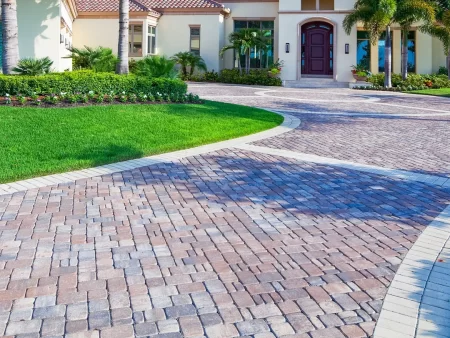
Anyone with pavers at their residence will tell you paver sealing is necessary. Unfortunately, it is also not an easy job to do, which is why you should let the pros help you out. Here we will delve into pavers’ issues and why paver sealing is such a great idea.
White lines on sealed surfaces are typically created for a few reasons-either the rolling method or dirty areas. Xylene may be utilized to remedy or eliminate dissolvent-based sealants, but H2O-based solutions demand powerful elements. Before waterproofing, the exterior needs to be washed with an efflorescence detergent. This extracts grime and rubbish on the sealer but likewise guarantees the deepest seal penetration and optimum product presentation. To eliminate roller lines, implement the sealer with a sprayer and delicately move it back and forth evenly. However, don’t roll when the product is dry.
An excessive amount of sealer can make the paver look like it is plastic. To obtain an even covering, it is better to utilize the atomizer device first and then apply the rolling technique. Sometimes, the plastic-like look of solvent-based sealant may be rectified with xylene.
One huge problem with paver sealing occurs when the sealant won’t adhere to the exterior. With a 90% chance, this is a straightforward consequence of a grimy exterior. This procedure demands totally withdrawing the sealant and completely washing the exterior with Efflorescence cleanser before sealing again.
Another paver sealing issue some may encounter is flashing. This will happen when the sealant is not smooth when applied to the paver. This happens when the exterior temp and/or atmosphere temp is super warm as the sealant is being used. As a common method based on practice, a hand examination must be performed if temps appear doubtful. If the bricks are too warm to feel, then they’re absolutely too warm for sealant. This is generally someplace between 60-80 degrees to be an exemplar.
One issue with paver sealing that you can avoid is white spots. You need to check the weather prior to using sealant, as these white spots will generally appear when moisture has been trapped. They will appear days or even several months after the sealing process has taken place. Be certain not to seal your pavers if there is a chance of rain up to 24 hours after completing the paving sealing. If you are looking to remove these, you may use Xylene.
Pavers may also have a tendency to turn yellow. However, this can be resolved by using paver sealing that is UV resistant.
Take note that you will want to remove any sand from the pavers before you complete paver sealing. Once the contaminated sand has been removed, use polymeric sand. Take note that if you decide to add new sand, you will still need to clean the paver afterward, prior to the paver sealing.
Sealing pavers eliminates water from soaking into the pavers, which assists in protecting the underneath elements from H2O damage. It likewise assists in preventing stains from forming, fading of the pavers, and being contaminated by grime, thus making them become discolored.
Sealing pavers may also stop weeds, moss, and other growth from growing up between the joints in the pavers.
If you live in the Tampa, FL, area and want paver sealing for your home, contact Unreal Paver Seal Tampa Bay. This family-owned company can provide the best service while fully guaranteeing their work
Picture Credit: iStock

